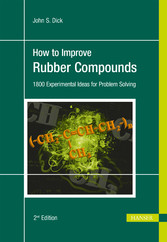John S. Dick
How to Improve Rubber Compounds
1800 Experimental Ideas for Problem Solving
Disclaimer
6
Preface
8
Contents
10
1 Introduction
16
1.1 Complexity of Compound Ingredient Selection
16
1.2 Industrial Complexity
18
1.3 Complexity of Ingredient Property Relationships
18
1.4 Experimental Ideas
21
1.5 Sources of Ideas
22
1.6 Review Panel
23
2 Improving the Physical Properties of Cured Rubber Compounds
24
2.1 Increasing Tensile Strength
24
2.2 Increasing High-Temperature Tensile Strength
38
2.3 Increasing Ultimate Tensile Elongation
40
2.4 Increasing Hardness and Modulus
45
2.5 Reducing Set, Under Compression and/or Tension
58
2.6 Increasing Rebound and Decreasing Hysteresis
67
2.7 Increasing Tear Resistance
84
2.8 Increasing Hot Tear Resistance
94
2.9 Improving Low-Temperature Properties
98
2.10 Increasing Electrical Conductivity
105
2.11 Increasing Thermal Conductivity
113
2.12 Decreasing Coefficient of Friction
116
2.13 Decreasing Air Permeability
117
2.14 Increasing Rubber-to-Metal Adhesion
120
2.15 Improving Rubber-to-Fabric Adhesion
125
2.16 Improving Flame Retardance
126
2.17 Reducing Compound Cost
130
3 Improving Degradation Resistance of Cured Rubber Compounds
140
3.1 Improving Hot Air and/or Heat Aging Resistance
140
3.2 Improving Ozone Resistance
159
3.3 Improving Flex Fatigue Resistance and/or Cutting and Chipping Resistance
168
3.4 Improving Abrasion and/or Wear Resistance
185
3.5 Improving Oil and/or Solvent Resistance
198
3.6 Improving Staining and Discoloration Resistance
207
3.7 Improving Weathering Resistance
209
3.8 Improving Hydrolysis Resistance
211
4 Optimizing Measurable Processability Properties
212
4.1 Reducing Viscosity
212
4.2 Increasing Shear Thinning
218
4.3 Reducing Elasticity (Nerve)
220
4.4 Increasing Tack
222
4.5 Reducing Stickiness to Metal Surfaces
227
4.6 Increasing Percent Dispersion of Carbon Black and Fillers
229
4.7 Increasing Green Strength
237
4.8 Increasing Scorch Safety Time
243
4.9 Increasing Cure Rate
254
4.10 Reducing Reversion
262
4.11 Reducing Marching Modulus
268
4.12 Reducing Cold Flow
269
5 Minimizing Adverse Processing Attributes
270
5.1 Reducing or Eliminating Porosity, Bubbles, or Voids in Both the Uncured and the Cured State
270
5.2 Mixing: Reducing Filler or Black Incorporation Times (BITs)
277
5.3 Mixing: Decrease Total Mixing Time
279
5.4 Mixing: Reducing or Eliminating Lumps in Dumped Batches
283
5.5 Mixing: Reducing Bagging on the Mill
284
5.6 Mixing: Reducing Back Rolling on the Mill
285
5.7 Extrusion: Reducing Die Swell (Improving Dimensional Stability)
286
5.8 Extrusion: Improving Smoothness of the Extrudate Surface
291
5.9 Extrusion: Increasing Extrusion Rate Without Loss of Quality
296
5.10 Calendering: Eliminating Blisters
302
5.11 Calendering: Improving Calender Release
304
5.12 Raw Material and Mixed Stock Bin Storage: Lengthening Useful Shelf Life
305
5.13 Mixed Stock Bin Storage: Reducing Bloom
306
5.14 Compression/Transfer/Injection Molding: Improving Mold Release
310
5.15 Compression/Transfer/Injection Molding: Reducing or Eliminating Mold Fouling
312
5.16 Compression/Transfer/Injection Molding: Improving Mold Flow
316
5.17 Compression/Transfer/Injection Molding: Reducing Shrinkage of Part
318
5.18 Compression/Transfer/Injection Molding: Improving Surface Appearance
321
5.19 Increasing the Blow Rate During the Curing of a Sponge Compound
322
5.20 Eliminating Trapped Air During Molding
325
5.21 Reducing Backrinding
326
6 Tire Performance Properties
328
6.1 Improving Tire Wet Traction
328
6.2 Improving Tire Dry Traction
336
6.3 Improving Tire Winter Traction or Ice Traction
338
6.4 Improving Tire Rolling Resistance
340
Appendix.1: Blends
350
A.1 Introduction
350
A.1.1 SBR/NR Blends
353
A.1.2 SBR/IR Blends
356
A.1.3 SBR/BR Blends
356
A.1.4 NR/BR Blend
358
A.1.5 NR/IR Blends
360
A.1.6 NR/CIIR Blends
360
A.1.7 NR/BIIR Blends
361
A.1.8 NR/BIMS Blends
361
A.1.9 NR/IIR Blends
362
A.1.10 CR/IIR Blends
362
A.1.11 NBR/SBR Blends
362
A.1.12 NBR/PVC Blends
363
A.1.13 XNBR/PVC Blend
364
A.1.14 NBR/IR Blends
364
A.1.15 NBR/BR Blends
365
A.1.16 NBR/NR Blends
365
A.1.17 EPDM/SBR Blends
365
A.1.18 EPDM/CR Blends
366
A.1.19 EPDM/IR Blends
366
A.1.20 EPDM/NR Blends
366
A.1.21 EPDM/CSM Blends
366
A.1.22 EPDM/Silicone Compatibilized
367
A.1.23 EPDM/LDPE Blend
367
A.1.24 EPDM/EVA Blend
367
A.1.25 CR/SBR Blends
367
A.1.26 CR/BR Blends
368
A.1.27 CSM/BR Blends
368
A.1.28 CR/Hydrin Blends
369
A.1.29 NBR/FA Polysulfide Rubber
369
A.1.30 Triblends
369
A.1.30.1 NR/SBR/BR Blends
369
A.1.30.2 BR/SBR/IR Blends
370
A.1.30.3 NR/IR/SBR Blends
370
A.1.30.4 NR/EPDM/BIIR Blends
371
A.1.30.5 NR/EPDM/CIIR Blends
371
A.1.30.6 NR/CR/CSM Blends
371
A.1.30.7 NBR/PVC/SBR Blends
371
A.1.30.8 XNBR/PVC/NBR Blends
372
A.1.30.9 XNBR/PVC/BR Blends
372
A.1.30.10 XNBR/NBR/BR Blends
372
A.1.30.11 NBR/SBR/BR Blends
372
A.1.30.12 NBR/BR/NR Blends
372
A.1.30.13 NR/EPDM/SBR Blends
372
A.1.30.14 EPDM/SBR/CR Blends
373
A.1.31 Four-Way Blends
373
A.1.31.1 NR/EPDM/SBR/CIIR Blends
373
Appendix.2: Cure Systems
374
A.2 Introduction
374
A.2.1 General Purpose Elastomer Cure Packages
374
A.2.2 EPDM Cure Packages
377
A.2.3 NBR Cure Packages
378
A.2.4 Polychloroprene Cure Packages
381
A.2.4.1 General Purpose Thiourea Cure Systems for Carbon Black Loaded CR Compounds
382
A.2.4.2 Special Purpose Thiourea Cure Systems for Carbon Black Loaded CR Compounds
382
A.2.4.3 General Purpose Non-thiourea Cure Systems for Carbon Black Loaded CR Compounds
382
A.2.4.4 Special Purpose Non-thiourea Cure Systems for Carbon Black Loaded CR Compounds
383
A.2.5 Chlorobutyl Rubber Cure Packages
384
A.2.6 Butyl Rubber Cure Packages
386
Review Panel Members’ Biographies
388
Author’s Biography
398
Subject Index
400
© 2009-2024 ciando GmbH
 Zu Hanser-Fachbuch.de
Zu Hanser-Fachbuch.de
 Warenkorb
Warenkorb
